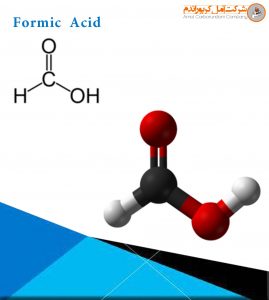Formic acid ( ant ink ) or methanoic acid is the simplest member of the carboxylic acid group. Its chemical formula is HCOOH and is found in nature in the bites of insects such as ants and bees. The main ingredient is also a biting substance in nettle leaves. The lexical root of formic acid is derived from the Latin name Ant (Formica). Because this compound was first obtained from the destructive distillation of ants.

Formic acid mixes well with water and most polar organic solvents. It is also partially soluble in hydrocarbons. Formic acid in the gaseous phase and in hydrocryns is in the form of dimers that are bonded together by hydrogen bonding. In the gas phase, the hydrogen bond between the formic acid molecules deviates from the law of ideal gases. Formic acid in liquid and solid form consists of an infinite network of molecules that are bonded together by hydrogen bonding. Most of the properties of formic acid are the same as those of other carboxylic acids.
Applications of formic acid
Formic acid is used as an additive in the food industry, in the production of aluminum catalysts, in the synthesis of drugs such as insulin and caffeine, in the synthesis of pentaerythritol, and in the production of epoxy soybean oil. It is also used in the production of insecticides, plant toxins and textile dyes. It should be noted that the main consumption of formic acid is used. It should be noted that the major consumption of formic acid in the world is in the field of chemical synthesis.
Formic acid is also used as a preservative (prevent spoilage) and antibacterial in animal feed. Sprinkling some of it on freshly dried grass prevents it from rotting and preserves its nutrients to a high degree. This substance is used to prevent spoilage of winter food in livestock in large livestock complexes.
Formic acid is added to poultry feed to kill Salmonella bacteria in poultry farms. It is also used sparingly in the textile and tanning industries. Some of its derivatives, such as formate esters, are used in the perfume industry.
Safety in the consumption of formic acid
Safety The greatest risk of formic acid is when the skin or eyes come in contact with a liquid or concentrated vapor. Skin contact with the liquid or its vapor causes chemical burns and in case of contact with the eyes may cause permanent damage to the eyes. Breathing its vapor stimulates and irritates the respiratory system. As CO levels may be present in formic acid vapor, safety precautions should be taken in storage, transportation, and use.
The US Food and Drug Administration has declared the permissible amount of formic acid vapor in the workplace air to be 5 ppm. Formic acid is easily metabolized and excreted from the body. However, constant exposure to it can cause chronic complications such as skin allergies. Experiments on laboratory animals show that prolonged exposure to formic acid causes gene mutations and kidney and liver damage.



